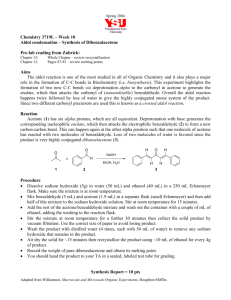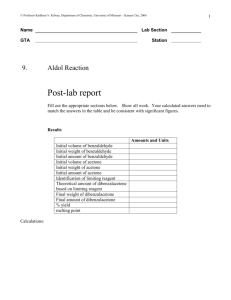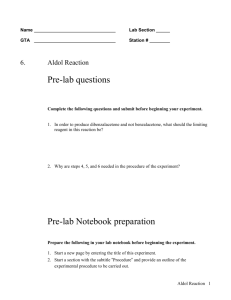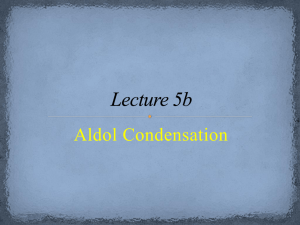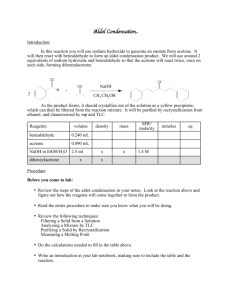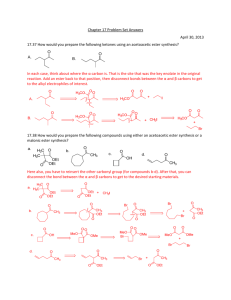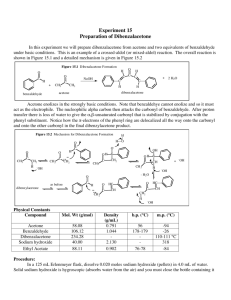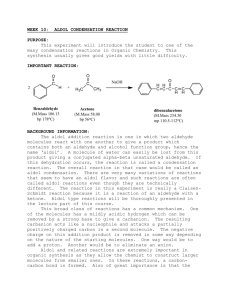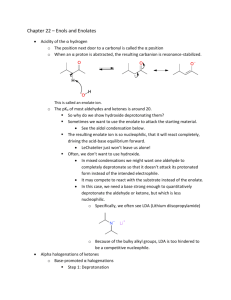9. Aldol Reaction - Web Pages - University of Missouri
advertisement
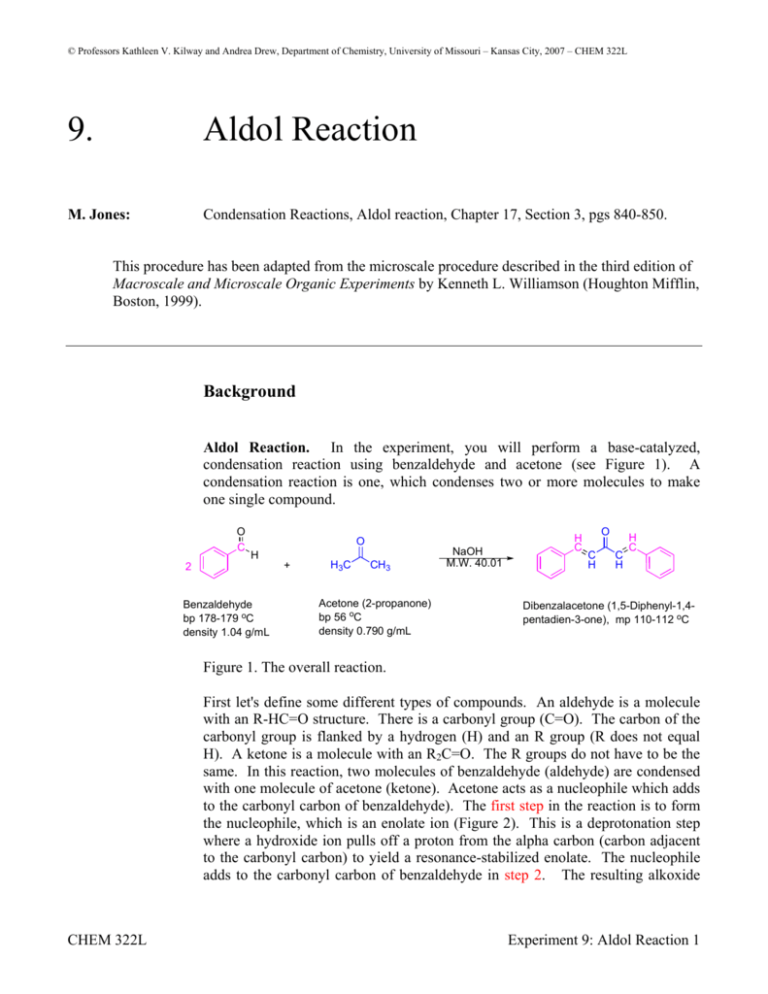
© Professors Kathleen V. Kilway and Andrea Drew, Department of Chemistry, University of Missouri – Kansas City, 2007 – CHEM 322L 9. Aldol Reaction M. Jones: Condensation Reactions, Aldol reaction, Chapter 17, Section 3, pgs 840-850. This procedure has been adapted from the microscale procedure described in the third edition of Macroscale and Microscale Organic Experiments by Kenneth L. Williamson (Houghton Mifflin, Boston, 1999). Background Aldol Reaction. In the experiment, you will perform a base-catalyzed, condensation reaction using benzaldehyde and acetone (see Figure 1). A condensation reaction is one, which condenses two or more molecules to make one single compound. O C O H + 2 Benzaldehyde bp 178-179 oC density 1.04 g/mL H3C CH3 Acetone (2-propanone) bp 56 oC density 0.790 g/mL NaOH M.W. 40.01 H C O C H C H H C Dibenzalacetone (1,5-Diphenyl-1,4pentadien-3-one), mp 110-112 oC Figure 1. The overall reaction. First let's define some different types of compounds. An aldehyde is a molecule with an R-HC=O structure. There is a carbonyl group (C=O). The carbon of the carbonyl group is flanked by a hydrogen (H) and an R group (R does not equal H). A ketone is a molecule with an R2C=O. The R groups do not have to be the same. In this reaction, two molecules of benzaldehyde (aldehyde) are condensed with one molecule of acetone (ketone). Acetone acts as a nucleophile which adds to the carbonyl carbon of benzaldehyde). The first step in the reaction is to form the nucleophile, which is an enolate ion (Figure 2). This is a deprotonation step where a hydroxide ion pulls off a proton from the alpha carbon (carbon adjacent to the carbonyl carbon) to yield a resonance-stabilized enolate. The nucleophile adds to the carbonyl carbon of benzaldehyde in step 2. The resulting alkoxide CHEM 322L Experiment 9: Aldol Reaction 1 ion is protonated in step 3 to form the "true" Aldol product which has both alcohol (OH) and carbonyl (C=O) functionalities. H3C O O O CH2 H H3C H3C CH2 CH2 + H2O resonance forms of enolate OH step 1: formation of the enolate H OH O C O(-) H H3C CH2 step 2: addition of enolate to PhCOH OH C H O HC H CH3 + H2O step 4: deprotonation of alpha carbon OH H C O C H O H2C CH3 step 3: protonation of alkoxide OH C H O (-) HC + H2O CH3 O C H CH3 step 5: elimination of hydroxide Figure 2. General reaction mechanism for the condensation of one molecule of benzaldehyde with one molecule of acetone. With heating, this product eliminates water (dehydration) to form an α,βunsaturated ketone. This happens first by a deprotonation step (step 4) with sodium hydroxide to form a resonance-stabilized carbanion. Then in step 5, a hydroxide ion is eliminated to form the α,β-unsaturated ketone called benzalacetone (mp 42 °C). The entire reaction sequence is repeated to condense another molecule of benzaldehyde to the second alpha carbon of acetone and form dibenzalacetone. Cautions and tips: - Make sure all glassware is clean. - Before you start the experiment, start the water bath and put ethanol on ice to save time. - If no crystals form, add a few drops of water to the solution and scratch the side of the tube with a stir rod. CHEM 322L Experiment 9: Aldol Reaction 2 Experiment Prepare an ice water bath for the recrystallization. Combine 0.6 mL of benzaldehyde (PhCOH), 0.2 mL of acetone (CH3COCH3), 4.0 mL of 5 M aqueous sodium hydroxide solution, and 8 mL of ethanol (CH3CH2OH) into your reaction tube and cap the tube. Make sure to record all amounts of starting materials. Shake the tube a few times every minute for a total of 30 minutes. After that time period, remove the liquid from the crystals using a pipette. Add 10 mL of water and shake the tube. Remove the water with a pipette and wash the tube two more times. Collect the crystals by vacuum filtration. Recrystallize the resulting crystals using ethanol. Cool the solution to room temperature. Then, put the reaction tube in an ice water bath. Vacuum filter and wash the crystals with a cold solution of ethanol/water (70:30). Dry and weigh the crystals, take a melting point and report the percent yield. CHEM 322L Experiment 9: Aldol Reaction 3
